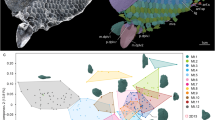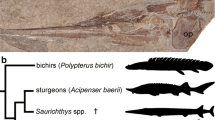Abstract
The development of the frontal bone and the formation of the first head scales are described during post-embryonic ontogeny of Hemichromis bimaculatus, using light and transmission electron microscopy. The frontal bone originates close to the cartilaginous taenia marginalis in a loose mesenchymal cell condensation (=primordium) lying 1 μm from the epidermis with which it establishes no cell contacts. The anlage appears at 4.2 mm standard length (SL) in the form of the membranodermal component of the bone, and extends first over the brain and then over the eye; the neurodermal component forms later to surround the supraorbital canal. The first head scales appear at 10.0 mm SL in a dense cell condensation (papilla) adjoining the epidermal-dermal junction and, once formed, remain in this position. In both organs, the initial matrix is similarly composed of “woven-fibred” bone that soon mineralizes in a similar manner to other dermal elements. In some areas of the frontal bone, “parallel-fibred” bone is deposited unequally on both surfaces, whereas isopedine is deposited in scales on the deep surface only. Osteoblastic features confirm this eccentric growth. Differences in the shape, organization and localization of the mesenchymal condensations giving rise to the frontal bone and to the scale reflect the existence of two types of dermal cell condensations. Our data are compared with those available for the post-cranial dermal skeleton of fishes both from a developmental and structural viewpoint. Structural differences in the matrices of the frontal bone and scales are discussed in a phylogenetic perspective.
Similar content being viewed by others
References
Aumonier FJ (1941) Development of the dermal bones in the skull of Lepidosteus osseus. Q J Microsc Sci 83:1–33
Becerra J, Montes GS, Bexiga SRR, Junqueira LCU (1983) Structure of the tail fin in teleosts. Cell Tissue Res 230:127–137
Daget J (1964) Le crâne des Téléostéens. Mém Mus Natn Hist Nat 31:163–341
Devillers C (1947) Recherches sur le crâne dermique des Téléostéens. Ann Paléontol 33:1–94
Ekanayake S, Hall BK (1988) Ultrastructure of the osteogenesis of acellular vertebral bone in the Japanese medaka, Oryzias latipes (Teleostei, Cyprinodontidae). Am J Anat 182:241–249
Géraudie J (1983) Contrôles morphogénétiques du développement et de la régénération des nageoires paires des Téléostéens. Thèse Doct ès-Science, Paris Arch Doc Inst Ethnol, micro-éd, Muséum national d'Histoire naturelle, SN 82-600-329
Géraudie J, Landis W (1982) The fine structure of the developing pelvic fin skeleton in the trout, Salmo gairdneri. Am J Anat 163:141–156
Hall BK (1978) Developmental and cellular skeletal biology. Academic Press, New York San Francisco London
Hall BK (1988) The embryonic development of bone. Am Sci 76:174–181
Huysseune A, Sire JY (1990) Ultrastructural observation on chondroid bone in Hemichromis bimaculatus (Teleostei, Cichlidae). Tissue Cell 22:371–383
Huysseune A, Sire JY (1992) Development of cartilage and bone tissues of the anterior part of the mandible in cichlid fish: a light and TEM study. Anat Rec 233:357–375
Krejsa RJ (1979) The comparative anatomy of the integumental skeleton. In: Wake MH (ed) Hyman's comparative vertebrate anatomy. University Chicago Press, Chicago London, pp 112–191
Lopez E, Baud CA, Boivin G. Lallier F (1978) Etude ultrastructurale, chez un poisson téléostéen, l'anguille (Anguilla anguilla L.) des processus de mineralization dans les cas d'une ossification perichondrale de l'arc branchial et d'une apposition secondaire dans l'os vertébral. Ann Biol Anim Biochem Biophys 18:105–117
Meunier FJ (1983) Les tissus osseux des Ostéichthyens. Structure, genèse, croissance et évolution. Thèse Doct ès-Science, Paris Arch Doc Inst Ethnol, Micro-éd, Muséum national d'Histoire naturelle, SN 82-600-328
Meunier FJ (1984) Spatial organization and mineralization of the basal plate of elasmoid scales in osteichthyans. Am Zool 24:953–964
Meunier FJ (1987) Os cellulaire, os acellulaire et tissus dérivés chez les Ostéichthyens: les phénomènes de l'acellularisation et de la perte de minéralisation. Année Biol 26:201–233
Neave F (1936) Origin of the teleost scale-pattern and the development of the teleost scale. Nature 137:1034–1035
Ørvig T (1967) Phylogeny of tooth tissues: evolution of some calcified tissues in early vertebrates. In: Miles AEW (ed) Structural and chemical organization of teeth, vol 1. Academic Press, London New York, pp 45–110
Ørvig T (1977) A survey of odontodes (“dermal teeth”) from developmental, structural, functional, and phyletic points of view. In: Andrews SM, Miles RS, Walker AD (eds) Problems in vertebrate evolution, Linnean Society Symposium 4, Academic Press, London New York, pp 52–75
Pinganaud-Perrin G (1973) Effets de l'ablation de l'oeil sur la morphogenèse du chondrocrâne et du crâne osseux de Salmo irideus Gib. Acta Zool 54:209–221
Reif WE (1982) Evolution of dermal skeleton and dentition in vertebrates. The odontode regulation theory. In: Hecht MK, Wallace B, Prauce GT (eds) Evolutionary biology, Plenum Press, New York, pp 287–368
Schultze HP (1977) Ausgangsform und Entwicklung der rhombischen Schuppen der Osteichthyes (Pisces). Paläontol Z 51:152–168
Sire JY (1985) Fibres d'ancrage et couche limitante externe à la surface des écailles du Cichlidae Hemichromis bimaculatus (Téléostéen, Perciforme): données ultrastructurales. Ann Sci Nat Zool Paris 13:163–180
Sire JY (1986) Ontogenic development of surface ornamentation in the scales of Hemichromis bimaculatus (Cichlidae). J Fish Biol 28:713–724
Sire JY (1987) Structure, formation et régénération des écailles d'un poisson téléostéen, Hemichromis bimaculatus (Perciforme, Cichlidé). Thèse Doct ès-Sciences, Paris Arch Doc Inst Ethnol, Micro-éd, Muséum national d'Histoire naturelle, SN 87 600 449
Sire JY (1988) Evidence that mineralized spherules are involved in the formation of the superficial layer of the elasmoid scale in the cichlids Hemichromis bimaculatus and Cichlasoma octofasciatum (Pisces, Teleostei): an epidermal active participation? Cell Tissue Res 253:165–172
Sire JY (1989) The scales in young Polypterus senegalus are elasmoid: new phylogenetic implications. Am J Anat 186:15–323
Sire JY (1990) From ganoid to elasmoid scales in the actinopterygian fishes. Neth J Zool 40:75–92
Sire JY (1993) Development and fine structure of the bony scutes in Corydoras arcuatus (Siluriformes, Callichthyidae). J Morphol 215:225–244
Sire JY, Arnulf I (1989) Squamation chronology and scale development in cichlids. Ann Mus R Afr Cent 257:97–100
Sire JY, Géraudie J (1983) Fine structure of the developing scale in the cichlid Hemichromis bimaculatus (Pisces, Teleostei, Perciformes). Acta Zool 64:1–8
Sire JY, Meunier FJ (1981) Structure et minéralisation de l'écaille d'Hemichromis bimaculatus (Téléostéen, Perciforme, Cichlidé). Archs Zool Exp Gén 122:133–150
Verraes W (1974a) Discussion on some functional-morphological relations between some parts of the chondrocranium and the osteocranium in the skull base and the skull roof, and of some soft head parts during postembryonic development of Salmo gairdneri Richardson, 1836 (Teleostei: Salmonidae). Forma Functio 7:281–292
Verraes W (1974b) Notes on the graphical reconstruction technique. Biol Jb Dodonaea 42:182–191
Verraes W, Ismail MH (1980) Developmental and functional aspects of the frontal bones in relation to some other bony and cartilaginous parts of the head roof in Haplochromis elegans Trewavas, 1933 (Teleostei, Cichlidae). Neth J Zool 30:450–472
Weiss RE, Watabe N (1979) Studies on the biology of fish bone. III Ultrastructure of osteogenesis and resorption in osteocytic (cellular) and anosteocytic (acellular) bones. Calcif Tissue Int 28:43–56
Author information
Authors and Affiliations
Rights and permissions
About this article
Cite this article
Sire, JY., Huysseune, A. Fine structure of the developing frontal bones and scales of the cranial vault in the cichlid fish Hemichromis bimaculatus (Teleostei, Perciformes). Cell Tissue Res 273, 511–524 (1993). https://doi.org/10.1007/BF00333705
Received:
Accepted:
Issue Date:
DOI: https://doi.org/10.1007/BF00333705




